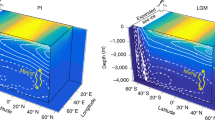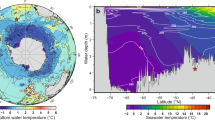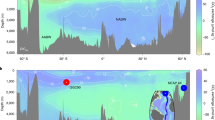Abstract
On timescales significantly greater than 105 years, atmospheric pCO2 is controlled by the rate of mantle outgassing relative to the set-point of the silicate weathering feedback. The weathering set-point has been shown to depend on the distribution and characteristics of rocks exposed at the Earth’s surface, vegetation types and topography. Here we argue that large-scale climate impacts caused by changes in ocean circulation can also modify the weathering set-point and show evidence suggesting that this played a role in the establishment of the Antarctic ice sheet at the Eocene–Oligocene boundary. In our simulations, tectonic deepening of the Drake Passage causes freshening and stratification of the Southern Ocean, strengthening the Atlantic meridional overturning circulation and consequently raising temperatures and intensifying rainfall over land. These simulated changes are consistent with late Eocene tectonic reconstructions that show Drake Passage deepening, and with sediment records that reveal Southern Ocean stratification, the emergence of North Atlantic Deep Water, and a hemispherically asymmetric temperature change. These factors would have driven intensified silicate weathering and can thereby explain the drawdown of carbon dioxide that has been linked with Antarctic ice sheet growth. We suggest that this mechanism illustrates another way in which ocean–atmosphere climate dynamics can introduce nonlinear threshold behaviour through interaction with the geologic carbon cycle.
This is a preview of subscription content, access via your institution
Access options
Access Nature and 54 other Nature Portfolio journals
Get Nature+, our best-value online-access subscription
$29.99 / 30 days
cancel any time
Subscribe to this journal
Receive 12 print issues and online access
$259.00 per year
only $21.58 per issue
Buy this article
- Purchase on Springer Link
- Instant access to full article PDF
Prices may be subject to local taxes which are calculated during checkout



Similar content being viewed by others
Change history
15 February 2017
In the version of this Article originally published, a sentence was mistakenly omitted from the Acknowledgements: "We thank John Higgins for insightful discussions, and for inspiring us to consider the role of silicate weathering." This has been corrected in all versions of the Article.
References
Kennett, J. P. Cenozoic evolution of Antarctic glaciation, the circum-Antarctic Ocean, and their impact on global paleogeography. J. Geophys. Res. 82, 3842–3859 (1977).
Ladant, J., Donnadieu, Y., Lefebvre, V. & Dumas, C. The respective role of atmospheric carbon dioxide and orbital parameters on ice sheet evolution at the Eocene–Oligocene transition. Paleoceanography 29, 1–14 (2014).
Pearson, P. N., Foster, G. L. & Wade, B. S. Atmospheric carbon dioxide through the Eocene–Oligocene transition. Nature 461, 1110–1113 (2009).
Eagles, G., Livermore, R. & Morris, P. Small basins in the Scotia Sea: the Eocene Drake passage gateway. Earth Planet. Sci. Lett. 242, 343–353 (2006).
Pagani, M. et al. The role of carbon dioxide during the onset of Antarctic glaciation. Science 334, 1261–1264 (2011).
Sijp, W. P. et al. The role of ocean gateways on cooling climate on long timescales. Glob. Planet. Change 119, 1–22 (2014).
Yang, S., Galbraith, E. & Palter, J. Coupled climate impacts of the Drake Passage and the Panama Seaway. Clim. Dynam. 43, 37–52 (2013).
Borrelli, C., Cramer, B. S. & Katz, M. E. Bipolar Atlantic deepwater circulation in the middle-late Eocene: effects of Southern Ocean gateway openings. Paleoceanography 29, 308–327 (2014).
Abelson, M., Agnon, A. & Almogi-Labin, A. Indications for control of the Iceland plume on the ‘greenhouse-icehouse’ climate transition. Earth Planet. Sci. Lett. 265, 33–48 (2008).
Hodell, D. A., Venz, K. A., Charles, C. D. & Ninneman, U. S. Pleistocene vertical carbon isotope and carbonate gradients in the South Atlantic sector of the Southern Ocean. Geochem. Geophys. Geosyst. 4, 1–19 (2003).
Langton, S. J., Rabideaux, N. M., Borrelli, C. & Katz, M. E. Southeastern Atlantic deep-water evolution during the late-middle Eocene to earliest Oligocene (Ocean Drilling Program Site 1263 and Deep Sea Drilling Project Site 366). Geosphere 12, 1032–1047 (2016).
Zanazzi, A., Kohn, M., MacFadden, B. J. & Terry, D. O. Jr Large temperature drop across the Eocene–Oligocene transition in central North America. Nature 445, 639–642 (2007).
Hren, M. T. et al. Terrestrial cooling in Northern Europe during the Eocene–Oligocene transition. Proc. Natl Acad. Sci. USA 110, 7562–7567 (2013).
DeConto, R. M. & Pollard, D. Rapid Cenozoic glaciation of Antarctica induced by declining atmospheric CO2 . Nature 421, 245–249 (2003).
Walker, J. C. G., Hays, P. B. & Kasting, J. F. A negative feedback mechanism for the long-term stabilization of Earth’s surface temperature. J. Geophys. Res. 86, 9776–9782 (1981).
Zeebe, R. E. & Caldeira, K. Close mass balance of long-term carbon fluxes from ice-core CO2 and ocean chemistry record. Nat. Geosci. 1, 312–315 (2008).
Berner, R. A., Lasaga, A. C. & Garrels, R. M. The carbonate-silicate geochemical cycle and its effect on atmospheric carbon dioxide over the past 100 million years. Am. J. Sci. 283, 641–683 (1983).
Goddéris, Y., Donnadieu, Y., Le Hir, G., Lefebvre, V. & Nardin, E. The role of palaeogeography in the Phanerozoic history of atmospheric CO2 and climate. Earth-Sci. Rev. 128, 122–138 (2014).
Maher, K. & Chamberlain, C. P. Hydrologic regulation of chemical weathering and the geologic carbon cycle. Science 343, 1502–1504 (2014).
Dessert, C., Duprè, B., Gaillardet, J., François, L. M. & Allègre, C. J. Basalt weathering laws and impact of basalt weathering on the global carbon cycle. Chem. Geol. 202, 257–273 (2003).
Dalai, T. K., Ravizza, G. E. & Peucker-Ehrenbrink, B. The Late Eocene 187Os/188Os excursion: chemostratigraphy, cosmic dust flux and the Early Oligocene glaciation. Earth Planet. Sci. Lett. 241, 477–492 (2006).
Goldner, A., Herold, N. & Huber, M. Antarctic glaciation caused ocean circulation changes at the Eocene–Oligocene transition. Nature 454, 979–982 (2008).
Merico, A., Tyrrell, T. & Wilson, P. A. Eocene/Oligocene ocean de-acidification linked to Antarctic glaciation by sea-level fall. Nature 454, 979–982 (2008).
Diester-Haass, L. & Zahn, R. Eocene–Oligocene transition in the Southern Ocean: history of water mass circulation and biological productivity. Geology 24, 163–166 (1996).
Pusz, A. E., Thunell, R. C. & Miller, K. G. Deep water temperature, carbonate ion, and ice volume changes across the Eocene–Oligocene transition. Paleoceanography 26 (2011).
Cramer, B. S., Toggweiler, J. R., Wright, J. D., Katz, M. E. & Miller, K. G. Ocean overturning since the Late Cretaceous: inferences from a new benthic foraminiferal isotope compilation. Paleoceanography 24 (2009).
Coxall, H. K., Wilson, P. A., Pälike, H., Lear, C. H. & Backman, J. Rapid stepwise onset of Antarctic glaciation and deeper calcite compensation in the Pacific Ocean. Nature 433, 53–57 (2005).
Liu, Z. et al. Global cooling during the Eocene–Oligocene climate transition. Science 323, 1187–1190 (2009).
Plancq, J., Mattioli, E., Pittet, B., Simon, L. & Grossi, V. Productivity and sea-surface temperature changes recorded during the late Eocene-early Oligocene at DSDP Site 511 (South Atlantic). Palaeogeogr. Palaeoclimatol. Palaeoecol. 407, 34–44 (2014).
Galbraith, E. D. et al. Climate variability and radiocarbon in the CM2Mc earth system model. J. Clim. 24, 4230–4254 (2011).
Acknowledgements
We thank J. Higgins for insightful discussions, and for inspiring us to consider the role of silicate weathering. Computational resources were provided by the Canadian Foundation for Innovation (CFI) and Compute Canada, through a resource allocation to E.G. Simulations were integrated on the Scinet general purpose cluster at the University of Toronto. The Canadian Institute for Advanced Research (CIFAR) and the Spanish Ministry of Economy and Competitiveness, through the María de Maeztu Programme for Units of Excellence in R&D (MDM-2015-0552), supported involvement of E.G. and an NSERC Discovery grant supported involvement of G.H.
Author information
Authors and Affiliations
Contributions
G.E. compiled geochemical data and prepared the manuscript. E.G. prepared the manuscript, performed model simulations and analysed simulation results. G.H. prepared the manuscript and assisted in analysis of geochemical data. S.Y. performed the model simulations and analysed simulation results.
Corresponding author
Ethics declarations
Competing interests
The authors declare no competing financial interests.
Supplementary information
Supplementary Information
Supplementary Information (PDF 2340 kb)
Supplementary Information
Supplementary Information (XLSX 59 kb)
Rights and permissions
About this article
Cite this article
Elsworth, G., Galbraith, E., Halverson, G. et al. Enhanced weathering and CO2 drawdown caused by latest Eocene strengthening of the Atlantic meridional overturning circulation. Nature Geosci 10, 213–216 (2017). https://doi.org/10.1038/ngeo2888
Received:
Accepted:
Published:
Issue Date:
DOI: https://doi.org/10.1038/ngeo2888
This article is cited by
-
Unraveling the Cenozoic carbon cycle by reconstructing carbonate compensation depth (CCD)
Science China Earth Sciences (2024)
-
Silicate weathering feedback hindered by clay formation
Nature Geoscience (2023)
-
Oxygenated deep waters fed early Atlantic overturning circulation upon Antarctic glaciation
Nature Geoscience (2023)
-
Dynamic modeling of tectonic carbon processes: State of the art and conceptual workflow
Science China Earth Sciences (2023)
-
Southern Ocean biogenic blooms freezing-in Oligocene colder climates
Nature Communications (2022)



